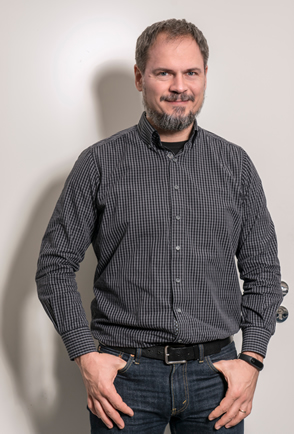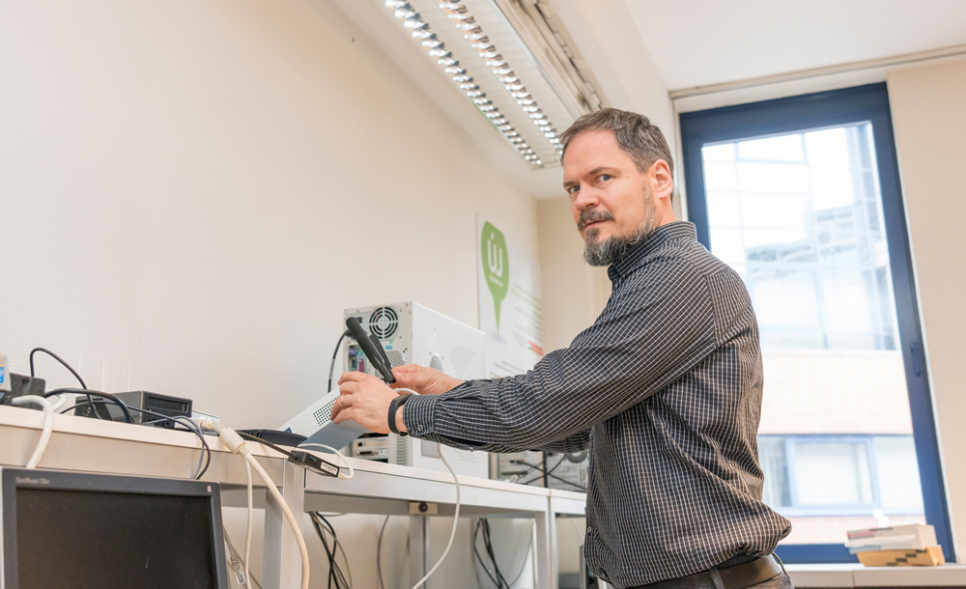
Pál Varga, Telecommunications Division Director at AITIA Internatonal Ltd.
The history of AITIA International Plc. started in the alma mater: the researchers, lecturers and doctoral students of the Budapest University of Technology and Economics and the Loránd Eötvös University of Sciences joined forces to work as a team of developers. The university context is still there, the heads of the company in their positions as lecturers meet nearly all students of electrical engineering and informatics in Budapest, which gives them the chance to select from the best ones. As a team they started with network monitoring: they studied the problems of calls in the network of Westel. Later on, they were complemented by a tema of artificial intelligence research and a team specialising in speech processing – this is how AITIA was constituted. “The initial good performance generated orders and after some time, we grew too big to operate within the university context, that is why we needed to set up a separate company” told us Pál Varga, member of the Board of Directors of the company about the beginning.
In the sector of mobile networks, they became known relatively fast, then in 2008-2009 the company was voted into the fifty fastest growing Central and Eastern European, as well as into the ten best Hungarian tech companies. “We made a relatively huge mistake with one of our large volume projects: we were ahead of our time”, says Varga. It happened in 2011 that they entered the market with a 100 gigabytes/sec network monitoring device, whereas households mostly had 10 megabytes/sec internet. The problem was that the sector had not yet decided the standard socket for similar cards. “We chose one, but it was not what the sector developed further” he said. Finally, they redesigned it and also sold some of this product but most importantly, the device inspired a large number of new ideas, which they were able to use later in other projects.
They connect electric cars with the network
The network card project drove the company into the universe of the Internet of Things (IoT). They realised that within a few years’ time, there would be billions of devices which are all Internet endpoints and they favourably need a shared protocol: they need to communicate with one another in one language. Due to the variety of protocols they found a plethora of challenges in the IoT universe; most of their supported projects target to solve problems along those lines.
“In a few years’ time we will move about in electric cars and the battery might start to be low, but there is no charger in the vicinity” Varga starts to talk about the problem. The solution of AITIA is that the car is not only trying to find the closest charging point on the map, but it communicates with the electric network of the environment and also with houses: it is trying to find the best priced energy. The software calculates which potential points are along the route and where it is the cheapest and the most efficient to purchase energy. They presented the operational Arrowhead system in December 2016 at a specialised expo in Florence, where they used toy cars, but the mobile application by that time had already been developed. “It is a complex task, the car, the charging points, the electric network, the mobile application and the map application all need to be on the same information sharing platform” the specialist explained. In addition, the company came up with a solution that supports secure information channelling among the software components of various stakeholders. “The system works on the basis of the service-based architecture, the applications exchange information in the form of services” he said.
The Arrowhead is not yet operational in the electric car industry, but there are smart buildings all over Europe where smart solutions are used within the framework system also developed by AITIA. They further develop the Arrowhead concept and technology and they continue to work with it in new international projects. The project was granted HUF 33.6 million from the NRDI Office.
They predict when something will break down
The IoT concept is further developed by the Mantis project amounting to HUF 47.5 million: this is the proactive operational architecture based on the cyber physical system. The endpoints of the IoT system, i.e. the specific devices, have a realisation in the real and cyber space as well, these are called digital twins. All devices get exhausted once, certain components need to be repaired or replaced. The optimum solution is not checking the device and replacing exhausted or defective components in it ex-post, but by modelling the use of the device they can predict when and which components will get worn out. They create a cyber model of the device, then by simulating itsuse, it is able to estimate in advance the best possible date for the replacement or repair of the given component.
This system is already operational in several prototypes: among other things they modelled a manufacturing line, which produces blades for electric shavers. “The solution is getting more and more popular, we got into the focus of the project, we have appeared in all publications concerning the issue and we are also in demand on the market” he said.
Their Diana project focuses on data processing. Each smart device collects data about its environment and the incoming information need to be processed and analysed. We have to think of systems, such as, for example, the telecommunications call data, fitness devices that can be worn on one’s body or data collected through voice technology. “We develop fast and accurate algorithms to be able to utilise the data in order to make devices even ‘smarter’” he said. This development is not as spectacular as IoT systems are, but they are indispensable when IoT systems are used. The question is how various different data may be channelled onto one platform and constitute a more complex information package at a higher level. According to Varga, they have already created several algorithms which are capable of solving the problem.
AITIA has contributed to every level of the Internet of Things. Arrowhead is a good example of the communication level of the IoT, the Mantis is a good example of the use of devices, whereas Diana, which was granted a funding of HUF 115.2 million, is a good example of processing data provided by devices. We basically develop internal network devices and solutions, says Varga. They work for several multinational companies with good reputation, nevertheless, consumers only know the large corporations, that is why AITIA is less in the focus of public attention. Our new products developed within projects are in the phase when the first parties with serious interest in them have appeared, he said. He hopes that the successes they had at the beginning of their IoT projects shall trigger an avalanche of orders, they make efforts to enter the market with their new products, as well.
Irrespective of that, AITIA has already worked out several solutions which are also known by the broader public: for example, if somebody leaves Hungary and receives a text message concerning his connection to the foreign service provider, that message arrives from the system of AITIA. They were also considerate and made efforts not to bother commuters: those who cross borders multiple times do not receive a message on every occasion. Several television programmes with a voting part in them use the AITIA system to receive votes cast on the phone, and the on-line captioning is also done by the speech recognition software of the company.
Today, AITIA can be considered as a global Hungarian brand, which is only known to field experts. Their mobile solutions are utilised in several places in Central and Eastern Europe, and they are active mostly in Europe, though they also sell solutions to the United States and the Far East. They concentrate more on the research-development area with mid- or long-range business focus but they have clear plans to enter the market with an increasing number of products, to grow and forge even better professional contacts.

To avoid parallel financing, due to another funding won from the NRDI Fund, funding agreement under VEKOP/CCHOP has not been concluded.






